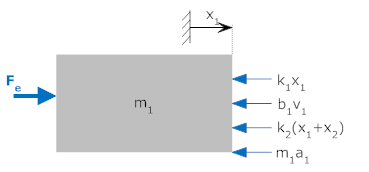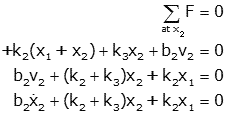|
There are 5 forces acting:
- The external force, Fe, to the right.
- The force due to k1.
- If x1 increases, k1 elongates
which causes a force at x1 to the left.
- The resulting force is k1·x1 to the left.
- The force due to b1.
- If x1 moves to the right (i.e., the positive
direction), the friction b1 causes a force (at x1) that is
to the left.
- The resulting force is b1·v1 to the left.
- The force due to k2.
- If x1 increases, k2 compresses which causes a
force at x1
to the left.
- If x2 increases, k2 compresses which causes a
force at x1
to the left.
- The resulting force is k2·(x1+x2)
to the left (or k2·(x2+x1)
to the right)
- The force due to m1 (don't forget this - the inertial
force!).
- The resulting force is m1·a1 to
the left (the inertial force is always in the opposite
direction from the define positive direction).
|
|
There are 3 forces acting:
- The force due to k2.
- If x1 increases (to the right), this
compresses the spring and causes a force to the right at x2.
- If x2 increases (to the left), this
compresses the spring and causes a force pulling x2 to the
right.
- The resulting force is k2·(x1+x2)
to the right.
- The force due to k3.
- If x2 increases, this elongates the spring and causes a
force to the right.
- The resulting force is k3·x2 to the
right.
- The force due to b2.
- If x2 moves to the left (i.e., the positive
direction), this elongates the dashpot and causes a
force to the right.
- The resulting force is b2·v2 to the left.
|




